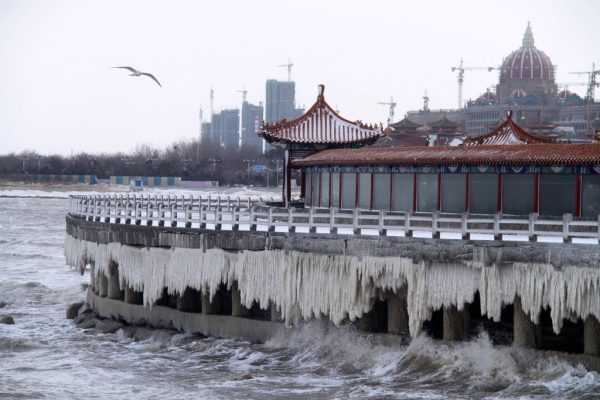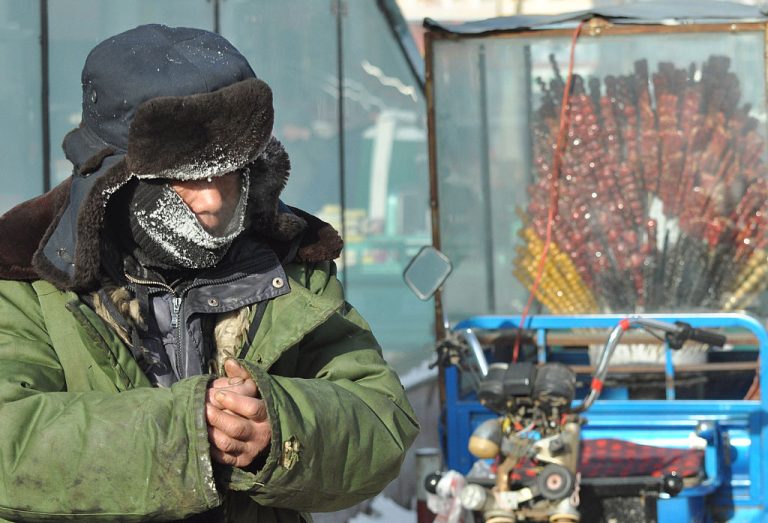Grappling against one of the most severe cold waves in recent history, authorities in China are racing against time to implement emergency measures, mobilize resources, and ensure the safety of millions of residents.
Following a period of unseasonably warm weather, large parts of the country’s central and eastern regions are now experiencing temperatures that are plunging rapidly. The cold snap is affecting daily life, infrastructure, and even the natural environment, local media reports.
On Jan. 21, China’s National Meteorological Center issued a yellow alert for the cold wave and blue alerts for heavy snow, ice, and wind in Northwest China. The alerted regions included: Gansu, Shaanxi, Xinjiang, and Qinghai. China employs a four-tier weather warning system, where red signifies the highest level of severity, followed in descending order by orange, yellow, and blue.
Cold wave onset
The cold wave, which began on Jan. 20, comes in stark contrast to the warm “Third Nine Days” of winter that preceded it. The term refers to a period used in the traditional Chinese weather system, which typically marks the 19th to 27th days following the Winter Solstice as being associated with milder winter weather.

According to the China Weather Network, regions such as Guizhou, Chongqing, Sichuan, Gansu, and Xinjiang experienced their warmest weather since 1961. However, during the “Fourth Nine Days” — the 28th to 36th days after the Winter Solstice, which typically mark the coldest part of winter — there was a drastic shift. The change in weather patterns led to temperature drops exceeding 57.2 degrees Fahrenheit (14° Celsius) in some areas.
Success
You are now signed up for our newsletter
Success
Check your email to complete sign up
The cold front has impacted a vast area, with even southern, warmer regions like Guangdong experiencing heavy rain and snow, and plummeting temperatures reaching as low as 10° Celsius.
RELATED: Massive Earthquake Rocks China as Rescue Efforts Are Hampered by Frigid Temperatures
In the north — particularly in the regions of Inner Mongolia and Heilongjiang — temperatures have dipped to a staggering -35°C to -40°C. Sun Jun, chief forecaster at China’s Weather Network, noted that the cold fronts will dump large amounts of snow in the country’s Northwestern provinces, and warned residents of potential disruptions to transportation and power supplies.
“Temperatures in parts of the Inner Mongolia autonomous region and the provinces of Shanxi and Hebei will plummet by more than 14°C,” said Sun, adding, “Special attention should be paid to the weather’s impact on transportation, energy supply, and electricity maintenance.”
Challenges to daily life and infrastructure
The freezing temperatures have posed significant challenges to daily life. In urban areas, the demand for heating has surged — putting a strain on already-struggling energy suppliers. Rural regions face even more acute challenges, with concerns about crop damage and the well-being of livestock. The cold has also disrupted transportation, with icy roads, sleet, and visibility issues leading to delays and accidents.
In response to the cold wave, local governments have initiated emergency protocols, including opening makeshift shelters and providing heating assistance to vulnerable populations. The China Weather Network has also issued warnings and advisories — urging residents to take precautions against the cold, such as wearing appropriate clothing, boarding up windows, and ensuring safe practices while venturing outside.
Beyond the immediate human impact, the cold wave could have significant environmental and economic implications. China’s Ministry of Emergency Management warned of potential disruptions to “key industries” as roads and power grids are impacted.
“It is important to focus on risk prevention in key industries and sectors and strengthen monitoring of road networks and inspections of ice accumulation on power grids,” the ministry said in a statement.
Economically, the cold wave could also impact agricultural output — particularly in southern regions where crops are less tolerant to freezing temperatures, the ministry added. “Personnel, materials and equipment should be assigned to key roads and regions in advance so that snow clearing can be carried out promptly.” it said.
Adapting to climate change
The current situation in China underscores the broader challenge of climate change and the increasing variability in weather patterns beyond Asia, experts note. According to non-partisan research firm, the Rhodium Group, other parts of the world have also experienced unusual weather patterns and sub-zero temperatures that are seemingly worsening over time.
“America’s greenhouse gas emissions from energy and industry rose last year, moving the nation in the opposite direction from its climate goals,” the firm found in 2022, adding, “Emissions ticked up 1.3 percent even as renewable energy surpassed coal power nationwide for the first time in over six decades.”
As China navigates the intricacies of this cold front, the focus remains on the safety and well-being of its citizens. Long-term, however, the extreme weather changes serve as a reminder of the need for continued research and policy development in the face of changing climates.
It also highlights the importance of proactive measures to mitigate the impacts of extreme weather events and adapt to an increasingly unpredictable global environment.













